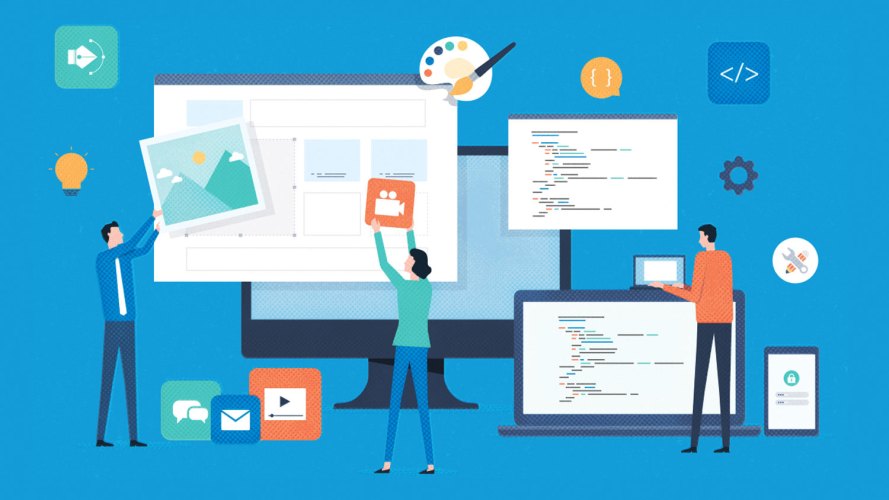Is It Better To Buy or Build Your Ecommerce Platform?



It doesn’t have to be one or the other. Many brands have a range of options depending on their needs.
As brands hustle to create compelling ecommerce experiences, they’re up against many challenges — limited time, rising consumer expectations, budget constraints, and more. Inevitably, they must decide whether to build or to buy an ecommerce platform. Considering that 56% of organizations expect the majority of their revenue to come from digital channels within the next three years, there’s a lot riding on getting the platform just right.
A rock-solid platform is the heart of ecommerce success. This includes a winning design, easily searchable catalogs, seamless payment workflows, and more — often at a global scale. So do you purchase a platform with these capabilities or build a completely custom solution?
The bad news: there’s no simple, one-size-fits-all answer. As cliched as it may sound, it really does depend. The good news: A few key considerations can help you arrive at your decision with confidence — and a plan. The better news: The answer doesn’t have to be so clear cut.
Looking for more commerce insights to drive growth?
Get tips, guides, and how-tos, curated just for you.



Consider necessary ecommerce features and capabilities
The difficulty of developing each feature of your ecommerce platform will depend on the nuances of your products, services, and industry. However, the core functionalities are the same for most brands regardless of the scale or scope of their business. These are the main pieces of an ecommerce puzzle, and it’s critical that they all fit together seamlessly, regardless of whether you build or buy:
- UX design and mobile responsiveness: Off-the-shelf, templated ecommerce sites with out-of-the-box tools for merchandising will undoubtedly save you money. However, some brands sell complex products and services that don’t quite fit into a template. Consider all of your options. For example, choose a partner that has industry-specific expertise and intimate knowledge of your products. Or start with a template, then build your own customizations for a faster deployment.
- Search and navigation: Brands with extensive catalogs want to offer easily discoverable goods and services. Personalized, relevant, and filterable search and results pages can mean the difference between a conversion and a bounce. In fact, one study found that 9 in 10 consumers say a good search function is “very important” or “absolutely essential,” with 97% agreeing that their favorite retail websites are ones where they can quickly find what they are looking for. Consider optimizing search capabilities with AI and product recommendation tools. This will drastically improve the shopping experience on your site, help your team meet revenue goals, and build brand loyalty.
- Checkout and payment: The checkout and payment workflows of an ecommerce site are multi-faceted, and new dimensions are added every day. Whether off-the-shelf or built by your team, checkout must be flexible and future-proof — so you can add new payment methods to the mix as they arise.
- Order management systems (OMS): If you build your OMS solution, this requires a large chunk of time and resources, and a development team with strong agile methodologies. Alternatively, extending your Enterprise Resource Planning (ERP) software by building OMS modules can introduce service experience complexities and create a divide between the back-end and front-end. Brands that purchase order management solutions can save time, money, and focus on their customers. An API-first OMS — one that can interact with external applications, operating systems, and data — makes search and inventory easily available to your business users without custom code.
The dynamic duo of time and cost
The time and cost of building a commerce platform or implementing an off-the-shelf product will vary depending on the size and scale of your business. Consider these factors when assembling a team or vetting third-party options:
- Time to market: Timing is everything — especially when it comes to ecommerce. Every day your launch is delayed means missed revenue, so it’s critical to keep things on track with your build or implementation. Create a clear workback schedule and solid go/no go dates before you start your deployment.
- Maintenance: The biggest cost (and perhaps the biggest challenge when it comes to ecommerce platforms) isn’t actually the initial build — it’s the ongoing maintenance and continuous development necessary to keep up with the breakneck pace of innovation in technology. Map out a maintenance plan as part of your build-vs.-buy decision, including the number of hours each month that will be dedicated to keep up development.
- Specialized labor: Finding developers with the right skills to build an ecommerce platform has never been a walk in the park. In the throes of the Great Resignation, it’s even more difficult. As brands across industries are investing more in website presence and digital transformation, developers are in high demand — and they aren’t cheap. To navigate this hurdle, prioritize the roles across your department you’d like to bring in-house — and outsource the rest.
- Intangible costs: Even after you hire your dream team for the build, it’s important to remember that employees come and go — and their historical knowledge of your business leaves with them. To avoid this, create a knowledge management plan in tandem with your new site. This way, no single employee is the linchpin of ecommerce running smoothly at your organization.
Reframing the build vs. buy decision
Brands that choose to build their own ecommerce platform often cite the need to customize — they veer away from off-the-shelf products because they want unparalleled control, freedom, and flexibility. After all, no third party will understand your needs better than you.
The conundrum many decision-makers find themselves in involves the need for customization and flexibility, while also acknowledging the finite supply of internal resources. Building an ecommerce platform typically means more flexibility than a structured solution — but it also means you’re limited by your own internal bandwidth. If you find yourself in this bind, a hybrid solution may be your answer.
Framing the build-vs-buy conversation as a spectrum of options rather than two singular choices can help many brands come to a more perfect ecommerce fit. For example, a brand can purchase a third-party solution to quickly achieve its share of the market, then dedicate internal resources to building capabilities and customizations once certain goals are met. With this approach, the profits earned after the initial launch can be used to pay for more advanced features in your roadmap.
Get the perfect fit with Commerce Cloud
- Operate at drag-and-drop speeds in a low code environment — so you can dedicate more resources to innovations that differentiate your brand.
- Create digital experiences that build brand loyalty with highly customizable, responsive user experience (UX).
- Take full control of your shopping experience with API-first ecommerce solutions.
- Extend ecommerce capabilities and add customizations with help from our AppExchange partners— in a matter of clicks.
Deciding on an ecommerce platform?
See how to choose the best one for your business.




























